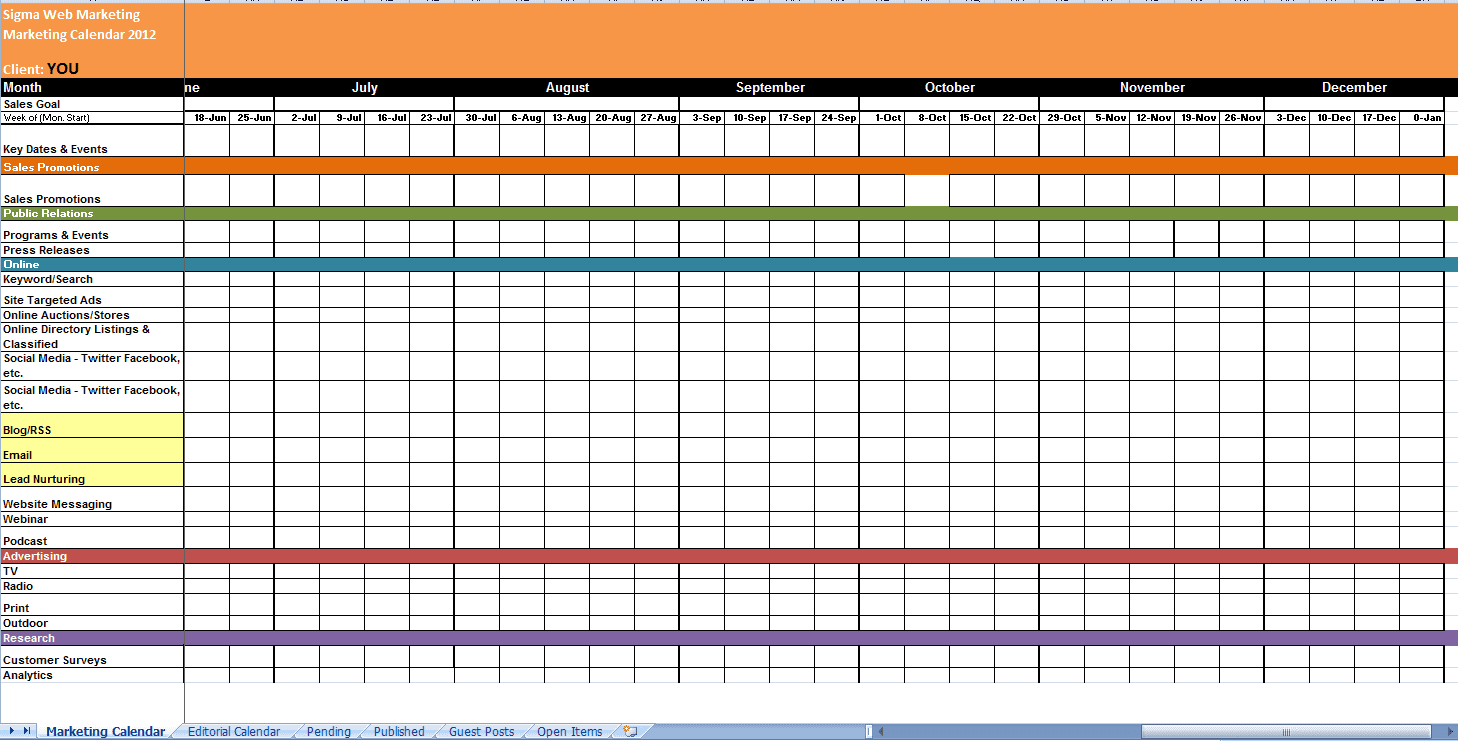This blog post is part of “The Ultimate Guide to Lead Generation” blog series.
Most of us are familiar with the idea of an editorial calendar – but how many of us actually use one?
A content marketing editorial calendar is very strategic. You need to understand your buyer personas and what motivates them, and you need to set clear goals. Like a traditional editorial calendar, it should show you what’s going on and what’s about to happen, as well as:
- Provide a place to generate post ideas and key topics.
- Assign writing and other editorial tasks to key members of your team.
- Create a publishing schedule that helps you maintain a consistent presence.
- Allow you to make in-process adjustments with drag-and-drop ease.
- Visualize your marketing strategy in a way that everyone can understand.
- Act as a communication point to team members.
Your content marketing editorial calendar should provide you and your team (and your boss?) a simple framework for well-planned campaigns that engage and educate your audience. You can view this as a strategic tool, but it’s also a way to keep your team focused and organized.
How we use our marketing and editorial calendar
We develop an editorial calendar for each client (and for ourselves!) and make sure to update each calendar quarterly. In fact, our content marketing editorial calendar has expanded to include:
- A marketing calendar of all upcoming marketing events and Gantt chart view of prep time needed for each event.
- An editorial calendar with target publishing dates for all our blog posts and premium content, along with authors, proposed title or topic, and notes that get published to the team automatically (thanks, Zapier!).
- A list of guest posts — both those that we’re writing for other blogs/magazines, and those that other authors are creating for us.
- An event marketing process that clearly defines when each piece of content is going to be released and insures that we have the appropriate landing pages, CTA, and emails in place before publication.
We use a separate content marketing editorial calendar for each client, as our client teams tend to operate pretty independently. We’ve found that using this tool helps us be more intentional about reaching client goals, and more consistent with our content creation. It also engages our clients’ audiences on a regular, consistent basis, building their thought leadership and branding.
How to manage your content marketing editorial calendar
If you’re ready to up your content marketing game for 2015 and start using an editorial calendar for your content marketing, you’re probably thinking about how to actually use this tool.
There are 7 things you need to keep an eye on as you implement this tool:
- What’s happening this week and next week? This should be easy to answer at all times.
- Does your team know what to do? Whether you’re “an army of one” or have a team of content writers, you can assign tasks to each team member and they’ll know what they are supposed to do and when they are supposed to do it.
- Is there a lot of communication about content? Discussing content and content ideas should be a normal daily part of your team’s communication process. Have a system in place that allows everyone to participate in discussion and share thoughts. And make sure someone acts as the proofreader for everything that goes out the door.
- Do you have the assets you need? Images and graphics are important, as are CTAs and landing pages. And don’t forget the lead nurturing emails. Use your editorial calendar to assign task for each of these to team members.
- Implement an editorial review process. We use a peer review process to improve the quality of our work. Gathering feedback from our peers is a quick and low-cost way to constantly improve the content that we create. Your calendar and editorial plan should accommodate for a step like this.
- Reschedule as needed. Nothing works exactly according to plan all the time – there will be times when you simply need to reschedule something. If you’re always looking out at least a couple weeks, you can usually avoid last minute changes.
- Keep an eye on your social media. Promoting your content on appropriate social channels is important as it helps spread your content and drive more traffic. Consider using Zapier or IFTTT to remind people in your organization that you’ve just published something new and want them to post it on their social media. Be sure to give them a short link to make this quick and easy.
Content marketing editorial calendars aren’t necessarily new, but you’d be surprised at how many people choose to not use them. This is their loss, and your advantage. The content marketers that dedicate themselves to great planning and creating content will always come out ahead: all this should lead to better content, produced more consistently, and provide a steady increase in traffic to your website.
This blog post is part of “The Ultimate Guide to Lead Generation” blog series.
2017 Marketing and Editorial Calendar
Successful marketing begins with a plan. Keep track of all your marketing efforts in one customizable marketing & editorial calendar.





